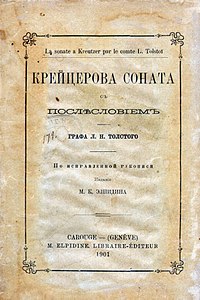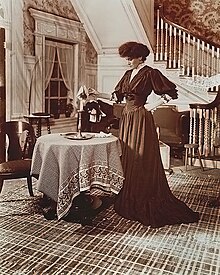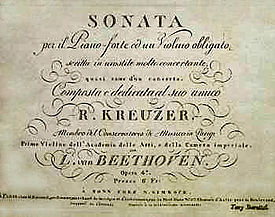Written by Andy Fein, luthier at Fein Violins
and Kevin Berdine
The birthday of the great French violinist Rodolphe Kreutzer is on November 15. This year, his birthday inspired a discussion in the shop about the Kreutzer Sonata, The Kreutzer Sonata, The Kreutzer Sonata, the Kreutzer Sonata, and a few more 'Kreutzer Sonata's. Of course, we mean, the sonata, the novella, the painting, the string quartet, a ballet, and several movies and plays. Too bad Rodolphe Kreutzer never played Beethoven's Kreutzer Sonata.
The piece that we now know as the "Kreutzer" Sonata, Ludwig van Beethoven's Violin Sonata No. 9, was originally dedicated to George Bridgetower with the following transcription: "Sonata mulattica composta per il mulatto Brischdauer [Bridgetower], gran pazzo e compositore mulattico" (Mulatto Sonata composed for the mulatto Brischdauer, big wild mulatto composer)." The first performance of this magnificent work, with Bridgetower sight-reading on the violin, and Beethoven at the piano was a tremendous success. The audience and performers alike, loved the piece so much that it was played back to back. After finishing the concert Beethoven and Bridgetower went out for some drinks whereupon Bridgetower insulted a woman whom Beethoven fancied. This was unacceptable to Beethoven so he removed the dedication to Bridgetower, and replaced it with a dedication to Rodolphe Kreutzer, the pre-eminent violin virtuoso of the day. To add insult to injury, Kreutzer never even played the piece. He claimed that the piece was "outrageously unintelligible." Truth-be-told, Kreutzer did not care for any of Beethoven's music. Unimaginable! Of course, we have all the details in a previous blog post on Beethoven's Kreutzer Sonata.
 Tolstoy tells the tale of a married couple whose intense love alternates with a tremendous hatred. Upon receiving contraceptives she begins to play the "Kreutzer" Sonata with a male violinist. The husband believes that some music is so powerful that it can alter one's internal compass and allow them to do things that are uncharacteristic (like cheat on your husband). Jealous of this new interest, her husband hides his rage to go on a train voyage. He returns early to find the two "Kreutzer" lovers and murders his wife with a dagger. The violinist escapes, to which the husband says "I wanted to run after him, but remembered that it is ridiculous to run after one's wife's lover in one's socks; and I did not wish to be ridiculous but terrible."
Tolstoy tells the tale of a married couple whose intense love alternates with a tremendous hatred. Upon receiving contraceptives she begins to play the "Kreutzer" Sonata with a male violinist. The husband believes that some music is so powerful that it can alter one's internal compass and allow them to do things that are uncharacteristic (like cheat on your husband). Jealous of this new interest, her husband hides his rage to go on a train voyage. He returns early to find the two "Kreutzer" lovers and murders his wife with a dagger. The violinist escapes, to which the husband says "I wanted to run after him, but remembered that it is ridiculous to run after one's wife's lover in one's socks; and I did not wish to be ridiculous but terrible."
In an epilogue published in 1890, Tolstoy adds:
"Let us stop believing that carnal love is high and noble and understand that any end worth our pursuit- in service of humanity, our homeland, science, art, let alone God -- any end, so long as we may count it worth our pursuit, is not attained by joining ourselves to the objects of our carnal love in marriage or outside it; that, in fact, infatuation and conjunction with the object of our carnal love (whatever the authors of romances and love poems claim to the contrary) will never help our worthwhile pursuits but only hinder them."
and Kevin Berdine
The birthday of the great French violinist Rodolphe Kreutzer is on November 15. This year, his birthday inspired a discussion in the shop about the Kreutzer Sonata, The Kreutzer Sonata, The Kreutzer Sonata, the Kreutzer Sonata, and a few more 'Kreutzer Sonata's. Of course, we mean, the sonata, the novella, the painting, the string quartet, a ballet, and several movies and plays. Too bad Rodolphe Kreutzer never played Beethoven's Kreutzer Sonata.
The piece that we now know as the "Kreutzer" Sonata, Ludwig van Beethoven's Violin Sonata No. 9, was originally dedicated to George Bridgetower with the following transcription: "Sonata mulattica composta per il mulatto Brischdauer [Bridgetower], gran pazzo e compositore mulattico" (Mulatto Sonata composed for the mulatto Brischdauer, big wild mulatto composer)." The first performance of this magnificent work, with Bridgetower sight-reading on the violin, and Beethoven at the piano was a tremendous success. The audience and performers alike, loved the piece so much that it was played back to back. After finishing the concert Beethoven and Bridgetower went out for some drinks whereupon Bridgetower insulted a woman whom Beethoven fancied. This was unacceptable to Beethoven so he removed the dedication to Bridgetower, and replaced it with a dedication to Rodolphe Kreutzer, the pre-eminent violin virtuoso of the day. To add insult to injury, Kreutzer never even played the piece. He claimed that the piece was "outrageously unintelligible." Truth-be-told, Kreutzer did not care for any of Beethoven's music. Unimaginable! Of course, we have all the details in a previous blog post on Beethoven's Kreutzer Sonata.
Anne Sophie Mutter performing Beethoven's Kreutzer Sonata
This piece was loved by audiences and innumerable performers throughout the years. One such lover of the "Kreutzer" Sonata was the Russian author Leo Tolstoy. While listening to the piece he was inspired to write his own novella title The Kreutzer Sonata. It was published in 1889, but immediately censored by the Russian authorities as its subject matter was too crude. It spoke against the notion of sexual abstinence and provided a detailed first-person account of rage brought on by a lover's jealousy. Tolstoy tells the tale of a married couple whose intense love alternates with a tremendous hatred. Upon receiving contraceptives she begins to play the "Kreutzer" Sonata with a male violinist. The husband believes that some music is so powerful that it can alter one's internal compass and allow them to do things that are uncharacteristic (like cheat on your husband). Jealous of this new interest, her husband hides his rage to go on a train voyage. He returns early to find the two "Kreutzer" lovers and murders his wife with a dagger. The violinist escapes, to which the husband says "I wanted to run after him, but remembered that it is ridiculous to run after one's wife's lover in one's socks; and I did not wish to be ridiculous but terrible."
Tolstoy tells the tale of a married couple whose intense love alternates with a tremendous hatred. Upon receiving contraceptives she begins to play the "Kreutzer" Sonata with a male violinist. The husband believes that some music is so powerful that it can alter one's internal compass and allow them to do things that are uncharacteristic (like cheat on your husband). Jealous of this new interest, her husband hides his rage to go on a train voyage. He returns early to find the two "Kreutzer" lovers and murders his wife with a dagger. The violinist escapes, to which the husband says "I wanted to run after him, but remembered that it is ridiculous to run after one's wife's lover in one's socks; and I did not wish to be ridiculous but terrible."In an epilogue published in 1890, Tolstoy adds:
"Let us stop believing that carnal love is high and noble and understand that any end worth our pursuit- in service of humanity, our homeland, science, art, let alone God -- any end, so long as we may count it worth our pursuit, is not attained by joining ourselves to the objects of our carnal love in marriage or outside it; that, in fact, infatuation and conjunction with the object of our carnal love (whatever the authors of romances and love poems claim to the contrary) will never help our worthwhile pursuits but only hinder them."
Tolstoys' novella was very popular, despite the authorities of Russia, the US, and other nations attempts to censor it. Theodore Roosevelt, a pretty tolerant and progressive President, even went as far as calling Tolstoy a "sexual moral pervert." The United States Post Office banned mailings of any newspaper that carried the serial publication of the novella. Its popularity is probably based mainly upon its own extraordinary merits, but it does not hurt to tell everyone that they CAN'T read it. Nothing excited the world like a prohibition of something tawdry.
Beethoven's "Kreutzer" inspired Tolstoy, but Tolstoy's work inspired many others. Many plays, a painting, a string quartet, and many movies have been derivatively created based upon Tolstoy's scandalous work.
 In 1901 a French painter, René François Xavier Prinet painted a picture of the two "Kreutzer"lovers at the piano. Instead of practicing, the violinist is distracted by his passion for the pianist and embraces her suddenly as her hands are still upon the piano. This painting became an advertisement for Tabu Perfume. The ad changed over the years, but often included a reference, at least, to the original painting.
In 1901 a French painter, René François Xavier Prinet painted a picture of the two "Kreutzer"lovers at the piano. Instead of practicing, the violinist is distracted by his passion for the pianist and embraces her suddenly as her hands are still upon the piano. This painting became an advertisement for Tabu Perfume. The ad changed over the years, but often included a reference, at least, to the original painting.
In 1902 Jacob Mikhailovich Gordin created Di Kreyster sonata, a Yiddish adaptation of Tolstoy's novella. Gordin was well-known for bringing Yiddish to the stage in a natural way. According to a Cambridge History, "Gordin took the Yiddish drama in America from the realm of the preposterous and put a living soul into it, bringing it up to the level of "realistic melodrama.""
In 1906, American playwright, Langdon Mitchell premiered his stage adaptation of Tolstoy's novella on Broadway. He, and director, Harrison Grey Fiske, essentially, brought Gordin's Yiddish version to an English-speaking audience.
In 1911, Pyotr Chardynin adapted and directed Tolstoy's novella into a moving picture. It was produced by Russian Empire. Only 3 years later, in 1914, Russian Empire produced another version, this time directed by Vladimir Gardin.
One year later, 1915, American, Herbert Brenon, directed it for American audiences.
In a dramatic bout of creativity, Between October 13th and October 28th of 1923, Janacek wrote a string quartet that was inspired by Tolstoy's novella. He had previously written a piano trio based on the same novella, but it has since been lost to history. One can only imagine what it may have sounded like by hearing the Quartet, and by looking at fragmentary segments of the trio that still exist. Janacek confides in a friend that "I was imagining a poor woman, tormented and run down, just like the one the Russian writer Tolstoy describes in his Kreutzer Sonata." His work, as is customary in his compositions, abandons traditional harmony and relies on the sonic variances that epitomize his output.
In the 20's, 30's, and 40's, 'The Kreutzer Sonata', the play and the movie, were directed and produced in Czechoslovakia, Germany, and Italy. In 1969, Yugoslavians witnessed the power of this novella as a TV adaptation directed by Jovan Konjovic.
 Since 1987, it has been made into movies, in the USSR, Italy, the UK, and its most recent remake in 2012, was in Spain directed by Jon Ander Tomas and starring Marina San Jose, Nacho Fresneda, and Javier Server. This film will premiere at the Navarre Film Festival in a few short weeks on December 13th at 10pm. More information about this latest version of the "Kreutzer" Sonata
Since 1987, it has been made into movies, in the USSR, Italy, the UK, and its most recent remake in 2012, was in Spain directed by Jon Ander Tomas and starring Marina San Jose, Nacho Fresneda, and Javier Server. This film will premiere at the Navarre Film Festival in a few short weeks on December 13th at 10pm. More information about this latest version of the "Kreutzer" Sonata
In 2000, the Carolina Ballet teamed up with choreographer, Robert Weiss to produce a multi-dimensional work containing music, dance, and drama. They used music from Beethoven, Janacek, and J. Mark Scearce while narrating and acting out scenes from Tolstoy's novella.
 |
| René François Xavier Prinet's "Kreutzer" Sonata |
 In 1901 a French painter, René François Xavier Prinet painted a picture of the two "Kreutzer"lovers at the piano. Instead of practicing, the violinist is distracted by his passion for the pianist and embraces her suddenly as her hands are still upon the piano. This painting became an advertisement for Tabu Perfume. The ad changed over the years, but often included a reference, at least, to the original painting.
In 1901 a French painter, René François Xavier Prinet painted a picture of the two "Kreutzer"lovers at the piano. Instead of practicing, the violinist is distracted by his passion for the pianist and embraces her suddenly as her hands are still upon the piano. This painting became an advertisement for Tabu Perfume. The ad changed over the years, but often included a reference, at least, to the original painting.In 1902 Jacob Mikhailovich Gordin created Di Kreyster sonata, a Yiddish adaptation of Tolstoy's novella. Gordin was well-known for bringing Yiddish to the stage in a natural way. According to a Cambridge History, "Gordin took the Yiddish drama in America from the realm of the preposterous and put a living soul into it, bringing it up to the level of "realistic melodrama.""
 |
| Character of Miriam Friedlander as directed by Fiske in Mitchell's Adaptation |
| Herbert Brenon |
 |
| Pyotr Chardynin |
In 1911, Pyotr Chardynin adapted and directed Tolstoy's novella into a moving picture. It was produced by Russian Empire. Only 3 years later, in 1914, Russian Empire produced another version, this time directed by Vladimir Gardin.
One year later, 1915, American, Herbert Brenon, directed it for American audiences.
In a dramatic bout of creativity, Between October 13th and October 28th of 1923, Janacek wrote a string quartet that was inspired by Tolstoy's novella. He had previously written a piano trio based on the same novella, but it has since been lost to history. One can only imagine what it may have sounded like by hearing the Quartet, and by looking at fragmentary segments of the trio that still exist. Janacek confides in a friend that "I was imagining a poor woman, tormented and run down, just like the one the Russian writer Tolstoy describes in his Kreutzer Sonata." His work, as is customary in his compositions, abandons traditional harmony and relies on the sonic variances that epitomize his output.
The Janacek Quartet performing Janacek's "Kreutzer Sonata" Quartet
In the 20's, 30's, and 40's, 'The Kreutzer Sonata', the play and the movie, were directed and produced in Czechoslovakia, Germany, and Italy. In 1969, Yugoslavians witnessed the power of this novella as a TV adaptation directed by Jovan Konjovic.
| Jon Ander Tomas |
In 2000, the Carolina Ballet teamed up with choreographer, Robert Weiss to produce a multi-dimensional work containing music, dance, and drama. They used music from Beethoven, Janacek, and J. Mark Scearce while narrating and acting out scenes from Tolstoy's novella.

No comments:
Post a Comment